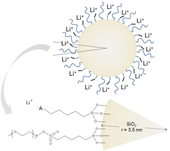Highlight
Nanostructured materials for high-performance lithium batteries
Achievement/Results
Working with a team of interdisciplinary engineers and scientists at Cornell University, NSF-funded IGERT Fellow Jennifer Schaefer has developed a new electrolyte for next-generation lithium ion batteries. Safety concerns have been raised about existing lithium ion batteries, in part because their electrolytes are highly combustible and may leak out of the battery during operation. Existing electrolytes are also incompatible with lithium metal anodes that have been proposed for higher energy density battery designs. For maximum performance, the current in an ideal electrolyte would be entirely carried by tiny, positively charged lithium ions, while the negative ions in the electrolyte would remain fixed in position. To accomplish this goal, the Cornell researchers physically tethered the negative ions to nanometer scale silica (sand) particles as shown in the accompanying figure. The resulting material was a conducting gel which displayed very good ionic conductivity at room temperature and excellent chemical stability even after a month of operation. The new material also delayed anode degradation and dendrite formation.
The researchers hypothesize that the new material may lead to improved lithium plating in rechargeable batteries with metallic lithium anodes. Optimization of the size, composition, and concentration of the nanoparticles and the negative ion chemistry will provide straightforward paths to further improvements in this new class of lithium electrolyte. Figure Caption: Schematic of the nanometric lithium salt developed by an interdisciplinary team of researchers at Cornell University for next-generation lithium ion batteries. Each nanoparticle has about 190 lithium ions and a comparable number of negative charges.
Schaefer, J. L., Yanga, D. A., & Archer, L. A. (2013). High Lithium Transference Number Electrolytes Via Creation of 3-Dimensional, Charged, Nanoporous Networks from Dense Functionalized Nanoparticle Composites. Chemistry of Materials, 25, 834-839.
Address Goals
Discovery: The development of sustainable materials for high-efficiency batteries is a technological and economic imperative.. Since their commercial introduction by Sony in 1991, lithium ion batteries have become the gold standard in rechargeable consumer electronics applications, primarily because of their high energy-to weight ratio. Nevertheless, recent high-profile failures have highlighted the shortcomings of current technology.
Learning: This Integrative Graduate Education and Research Traineeship (IGERT) program is providing the next generation of scientists and engineers with the knowledge and skills necessary to solve the biggest problem challenging mankind: ensuring a sustainable future. This advance involved an IGERT Fellow in a team-based, interdisciplinary project. A recent National Academies report concluded that in-depth research experience is the crucial component in graduate education. A team-based approach provided the necessary broad skillset while also providing the Fellow with an introduction to sustainable R&D.






